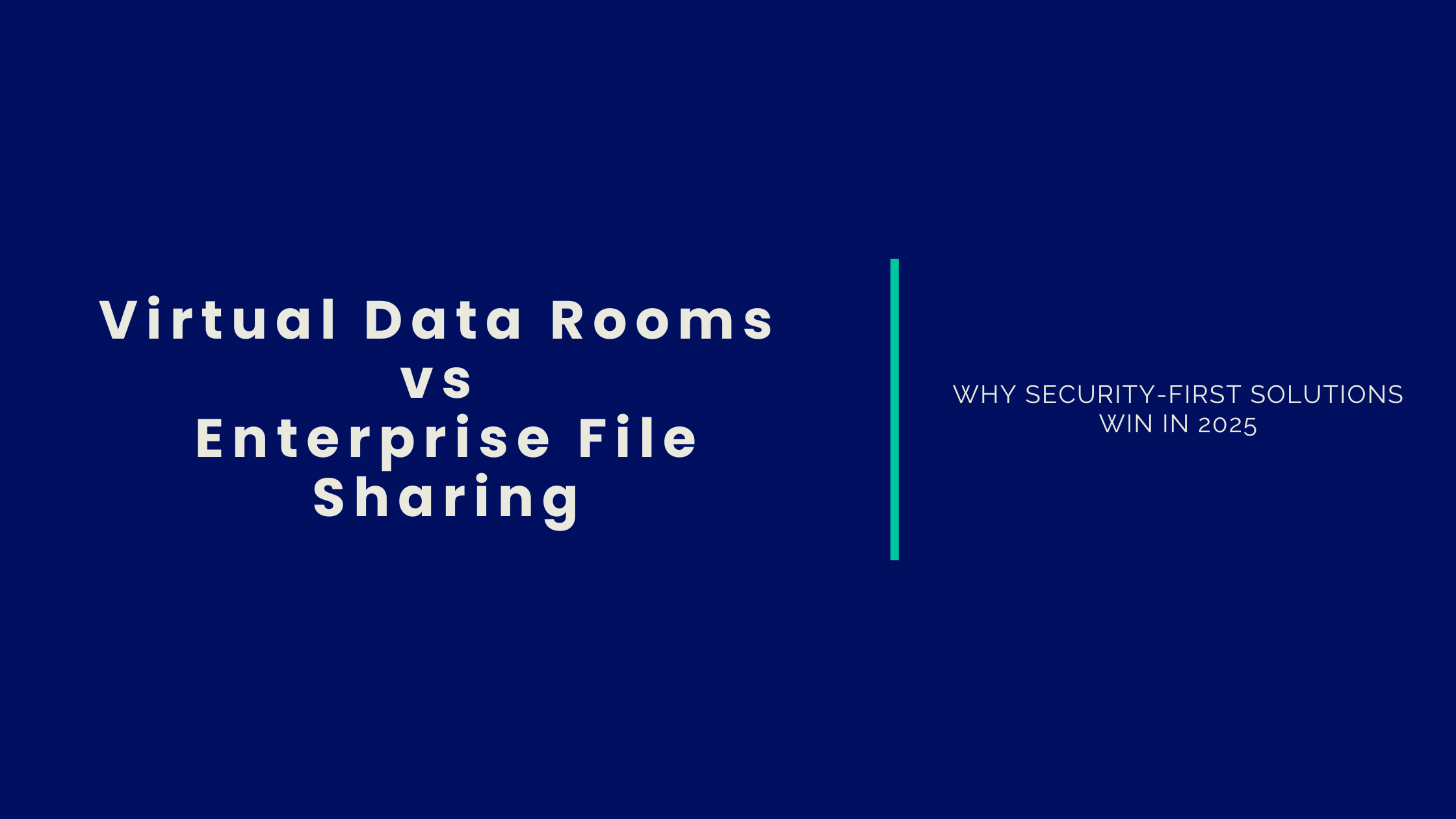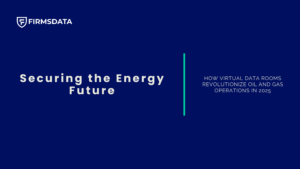In today’s rapidly evolving digital landscape, the distinction between enterprise file sharing (EFS) solutions and Virtual Data Rooms (VDRs) has become more critical than ever. While both platforms facilitate secure document management and collaboration, they serve fundamentally different purposes and offer varying levels of protection for sensitive business information.
As cyber threats continue to escalate—with data breaches averaging $4.88 million in 2024—organizations must carefully evaluate their file sharing and storage solutions. This comprehensive analysis explores why Virtual Data Rooms like FirmsData represent the gold standard for secure document management, particularly in high-stakes business environments.
Understanding the Enterprise File Sharing Landscape
Enterprise file sharing solutions have become ubiquitous in modern business operations, offering organizations a unified platform for stakeholders to share files and collaborate regardless of location. Popular EFS platforms include Google Drive, Microsoft OneDrive, and Dropbox, which provide basic cloud storage and synchronization capabilities.
These solutions excel in several key areas:
Team Collaboration: EFS platforms enable employees to work on documents simultaneously with real-time editing and commenting features.
Remote Work Support: They allow employees to access and work on files from anywhere using any device, supporting flexible work arrangements.
Data Backup: Automatic backup features help prevent data loss and protect against hardware failures.
File Version Control: EFS solutions track changes and allow users to restore previous versions when needed.
However, the convenience of enterprise file sharing comes with significant security limitations that become apparent when handling sensitive business data.
The Growing Security Gap in Enterprise File Sharing
Despite their popularity, enterprise file sharing solutions face several critical security challenges that can expose organizations to substantial risks:
Data Breach Vulnerabilities
The statistics are alarming: over 10,000 confirmed data breaches occurred in 2024, nearly doubling from the previous year. Enterprise file sharing platforms are particularly vulnerable because they prioritize accessibility over security. Basic encryption and limited compliance features leave sensitive documents exposed to unauthorized access.
Human Error Risks
Research indicates that a large share of cloud data breaches result from human error. EFS platforms make it easy for employees to accidentally share confidential files with wrong recipients or upload sensitive documents to unsecured locations. Once files are shared via basic cloud storage, organizations lose control over how the information is accessed, downloaded, or redistributed.
Shadow IT Challenges
A significant share of companies are unaware that employees use unapproved file-sharing tools. This “Shadow IT” phenomenon occurs when employees bypass approved enterprise systems and use personal cloud accounts like Google Drive or Dropbox for work files. These unauthorized platforms often lack enterprise-grade security features, creating significant vulnerabilities.
Compliance Failures
Industries like healthcare, finance, and legal services must follow strict regulations such as HIPAA, GDPR, and CCPA. Standard EFS solutions often lack the sophisticated compliance features required by these regulations, potentially exposing organizations to legal penalties and reputational damage.
Virtual Data Rooms: The Security-First Alternative
Virtual Data Rooms represent a paradigm shift from convenience-focused file sharing to security-first document management. Unlike general EFS solutions, VDRs are specifically designed for handling confidential information in high-stakes business scenarios.
Advanced Security Architecture
VDRs implement military-grade security measures that far exceed standard cloud storage capabilities:
- AES-256 Encryption: Data remains protected both at rest and in transit using advanced encryption standards.
- Multi-Factor Authentication: Layered authentication requiring multiple verification methods significantly reduces unauthorized access risks.
- Granular Access Controls: Role-based permissions ensure users access only specific documents necessary for their responsibilities.
- Real-Time Monitoring: Automated systems detect unusual access patterns and trigger immediate alerts for suspicious activities.
Comprehensive Audit Capabilities
One of the most significant advantages of VDRs over EFS solutions is their comprehensive audit functionality. VDRs maintain detailed logs of every user action, including document views, downloads, and modifications. This creates complete accountability and provides forensic capabilities essential for regulatory compliance and legal proceedings.
Data Loss Prevention
Advanced DLP features in VDRs prevent unauthorized data extraction through screenshot blocking, print restrictions, and document watermarking. These capabilities ensure that even if authorized users access documents, they cannot easily compromise the information’s integrity or confidentiality.
Market Dynamics and Growth Trends
The virtual data room market is experiencing unprecedented growth, reflecting the increasing demand for secure document management solutions. The global VDR market was valued at several billion dollars in 2024 and is projected to grow robustly through the next decade.
Several factors drive this remarkable growth:
Digital Transformation Acceleration
The emergence of digital transformation initiatives has highlighted the importance of accessible, cloud-based solutions that don’t compromise security. Organizations are increasingly recognizing that traditional EFS solutions cannot meet the sophisticated security requirements of modern business operations.
Regulatory Compliance Demands
Growing regulatory pressures across industries have made compliance a non-negotiable requirement. VDRs offer built-in compliance features for GDPR, HIPAA, and other industry-specific regulations, making them essential for organizations handling sensitive data.
M&A Activity Growth
Robust merger and acquisition activity drives demand for secure due diligence platforms, where VDRs excel compared to standard file sharing solutions.
Detailed Feature Comparison: VDRs vs Enterprise File Sharing
| Feature | Virtual Data Rooms | Enterprise File Sharing |
| Security Level | Advanced: granular permissions, watermarking, redaction, IP restrictions | Standard: basic permissions, encryption, activity logs |
| Use Cases | M&A, fundraising, litigation, confidential projects | Team collaboration, internal file sharing, remote work |
| Access Management | Strict controls, role-based access, time-limited viewing | Less advanced access controls for teams and external stakeholders |
| Compliance Focus | Strictly focused on compliance and regulations | Less focused on compliance and regulations |
| File Handling | Optimized for confidential and sensitive documents | Suitable for different document types |
| Customization | Highly customizable interfaces and branding | Limited customization options |
| Pricing | Typically costlier due to specialized features | Generally more affordable with scalable plans |
| Collaboration Tools | Focused on advanced Q&A workflows | Focused on tools like real-time editing and integrations |
Industry-Specific Applications
Investment Banking and M&A
Investment banks require secure platforms for managing complex M&A transactions throughout the entire lifecycle. VDRs provide the sophisticated security and collaboration features necessary for due diligence processes, financial document sharing, and stakeholder coordination. The ability to track document access and user activity is crucial for maintaining deal confidentiality and regulatory compliance.
Legal and Compliance
Legal firms handling sensitive litigation documents, intellectual property, and confidential client information require more than basic file sharing. VDRs offer advanced features like document redaction, secure Q&A workflows, and detailed audit trails that are essential for legal proceedings and regulatory compliance.
Life Sciences and Healthcare
Healthcare organizations and life sciences companies must comply with strict HIPAA regulations while managing sensitive patient data and clinical trial information. VDRs provide the specialized security features and compliance certifications necessary for protecting healthcare information while enabling collaboration among researchers, regulatory bodies, and healthcare providers.
Real Estate
Real estate projects involve sharing large volumes of documents with multiple stakeholders, including contractors, financial institutions, and government departments. VDRs offer the security and organization capabilities necessary for managing complex real estate transactions while maintaining confidentiality and regulatory compliance.
Cost-Benefit Analysis: ROI of Virtual Data Rooms
While VDRs typically cost more than basic enterprise file sharing solutions, the return on investment often justifies the additional expense through several key benefits:
Time Savings and Efficiency
Organizations using VDRs typically experience significant time savings in document management and collaboration. Teams can save several hours per week per user, resulting in substantial annual savings when factoring in employee hourly rates. This translates to a high potential ROI compared to VDR implementation costs.
Risk Mitigation
The average cost of a data breach is significant. VDRs reduce security risks by a large margin compared to traditional file sharing methods, potentially saving organizations millions in breach-related costs, legal fees, and reputational damage.
Faster Deal Closure
VDRs accelerate M&A deals, due diligence processes, and legal proceedings by enabling secure real-time collaboration. Organizations typically see much faster transaction completion, which can significantly impact revenue and competitive positioning.
Compliance Cost Avoidance
Regulatory non-compliance can result in substantial fines and legal penalties. VDRs help organizations avoid these costs by providing built-in compliance features and audit capabilities that satisfy regulatory requirements.
Advanced Security Features That Matter
Zero-Trust Architecture
Modern VDRs implement zero-trust security models that verify every user and device before granting access. This approach assumes no user or system is inherently trustworthy, providing an additional layer of protection against both external threats and insider risks.
Digital Rights Management
Advanced VDRs offer sophisticated digital rights management capabilities that control how documents can be used even after download. Features include:
- Dynamic Watermarking for traceability and deterrence against unauthorized sharing
- Print Restrictions to prevent unauthorized physical copies
- Screenshot Prevention to protect document integrity
- Remote Access Revocation to instantly remove access even after download
AI-Powered Security
Leading VDR providers incorporate artificial intelligence to enhance security, including:
- Automated Redaction of sensitive data
- Anomaly Detection by machine learning of unusual access
- Content Classification to categorize document sensitivity
- Risk Scoring to assess security risks continuously
Implementation Best Practices
Planning and Setup
Successful VDR implementation requires careful planning and strategic setup:
- Define Security Requirements according to industry standards
- Establish clear User Roles with appropriate access permissions
- Organize documents logically for easy navigation and security
- Provide comprehensive training to all users for security awareness
Ongoing Management
Effective VDR management requires continuous attention:
- Regularly review user access permissions
- Conduct security audits to identify vulnerabilities
- Monitor user activities continuously for suspicious events
- Maintain robust backup and disaster recovery plans
Future Trends and Innovations
Integration Capabilities
Modern VDRs are evolving to integrate seamlessly with broader enterprise systems such as CRM, legal case management, workflow, and analytics platforms, ensuring secure yet efficient workflows.
Mobile Security
VDRs are enhancing mobile security with device management, biometric authentication, offline encrypted access, and mobile-optimized user interfaces.
Blockchain Integration
Blockchain is being explored for immutable audit trails and document integrity verification, increasing trust in digital transactions.
Conclusion: Making the Right Choice for Your Organization
The choice between enterprise file sharing and Virtual Data Rooms depends on security needs, risk tolerance, and business complexity. For organizations managing sensitive information in regulated or high-stakes environments, VDRs offer indispensable security, compliance, and efficiency benefits.
Organizations prioritizing data confidentiality, regulatory compliance, and transaction speed will find Virtual Data Rooms, like those offered by FirmsData, provide best-in-class solutions to protect their information assets while fueling business growth.
Choosing a VDR is a strategic imperative for secure document management in the digital age.





